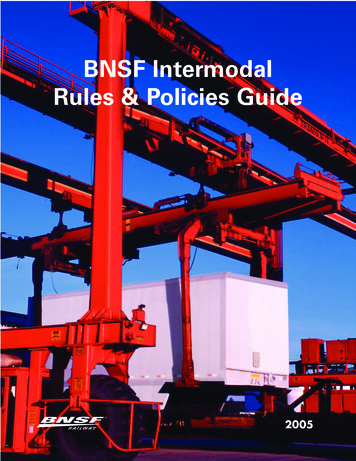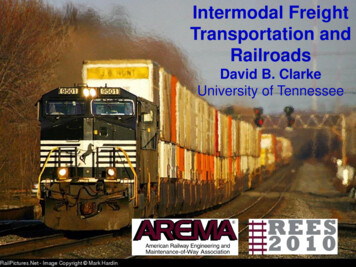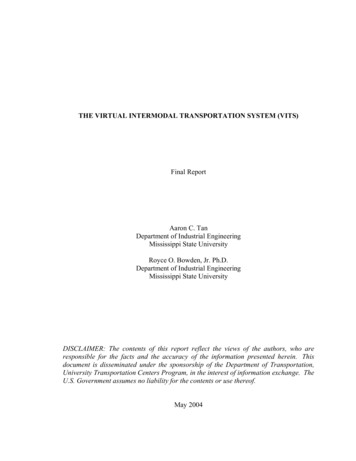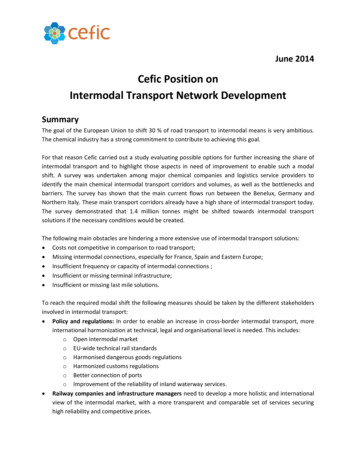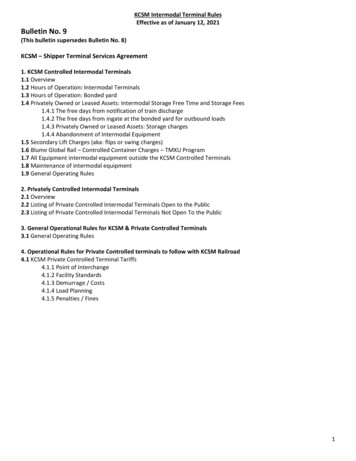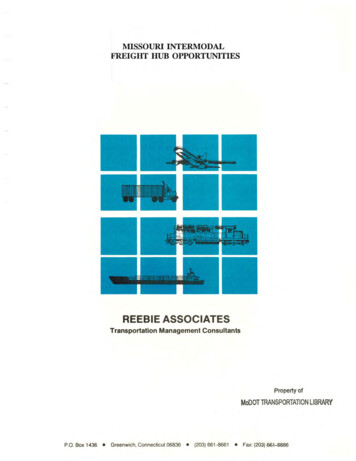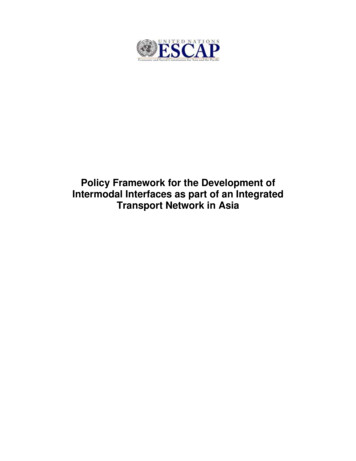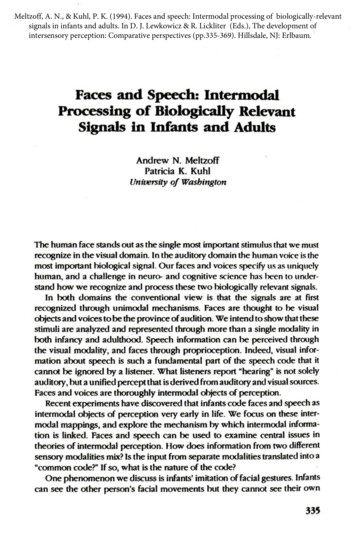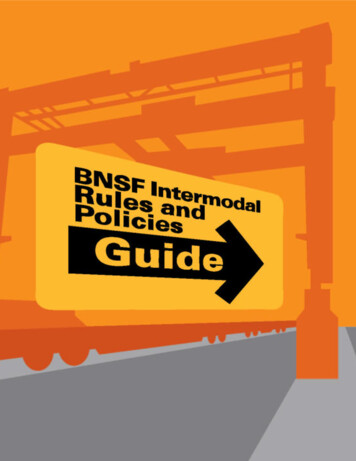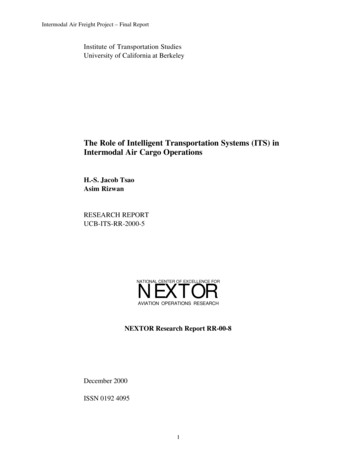
Transcription
Intermodal Air Freight Project – Final ReportInstitute of Transportation StudiesUniversity of California at BerkeleyThe Role of Intelligent Transportation Systems (ITS) inIntermodal Air Cargo OperationsH.-S. Jacob TsaoAsim RizwanRESEARCH REPORTUCB-ITS-RR-2000-5NATIONAL CENTER OF EXCELLENCE FORNEXTORAVIATION OPERATIONS RESEARCHNEXTOR Research Report RR-00-8December 2000ISSN 0192 40951
Intermodal Air Freight Project – Final ReportIntermodal Air Cargo Operations And The Role of IntelligentTransportation Systems (ITS)TABLE OF CONTENTSAcknowledgment .4Abstract .5Extended Executive Summary 61. Background .211.1 Study Objectives 211.2 Study Approach and Scope .221.3 Organization of Report .252. Overview of the Air Cargo Industry 252.1 Role of the Air Cargo Industry in Goods Movement .252.2 Air Freight in California 292.3 Overview of Site Visits 322.4 Integrated Air-Express Forwarding .332.5 Performance Measures for Air Cargo Operations 373. Public-Sector Innovation Opportunities for Solving The Problems and IssuesFaced By The Integrated Air-Express Forwarders In The State .393.1 Issues, Problems And Possible Solutions Suggested By The Operators .393.2 Other Public-Sector Innovation Opportunities 424. The Role of ITS in the Air Cargo Industry .454.1 Current Success Stories of ITS in Air Cargo Operations 454.2 Possible Future Roles of ITS and Other Advanced Technologies in IntegratedAir-express Forwarding .534.3 Role of the Government in Deployment of ITS for the Air Cargo Industry 595. Lessons Learned from the Integrated Air-Express Industry in the Areas of ITSDeployment and the Intermodal Services . .602
Intermodal Air Freight Project – Final Report5.1 ITS Deployment .615.2 Intermodal Transportation Services 666. Conclusion .68References .71Appendix A: Planned Discussion Subjects During Site Visits 74Appendix B: Site-visit Report - Airborne Express, Mather Airport (Sacramento) .77Appendix C: Site-visit Report - Federal Express, San Ramon Dispatch Center ForThe Dispatching Operations In The San Francisco Bay Area .81Appendix D: Site-visit Report - Federal Express, Oakland Regional Hub . .88Appendix E: Site-visit Report - UPS Western Region Hub At Ontario InternationalAirport .91Appendix F: Site-visit Report - Southern California Logistics Airport: . .93Appendix G: Site-visit Report - Northwest Airlines .95Appendix H: Site-visit Report - Nippon Cargo Airlines .97Appendix I: Salient Features Of Integrated Air-Express Forwarding .98Appendix J: The Ground Operations Of Integrated Air-Express Forwarding And TheirSalient Features .105Appendix K: The Airport Operations Of Integrated Air-Express Forwarding And TheirSalient Features .111Appendix L: Performance Measures For Air Cargo Movement .116Appendix M: Performance Measures Of The Public Sector On Intermodal GroundOperations .119Appendix N: Performance Measures Of The Integrators’ Services .122Appendix O: Specific Issues And Problems Faced By The Operators In The State AndPublic-Sector Innovation Opportunities .125Appendix P: ITS Technologies In Use Or Being Tested For Trucking And TheGround Operations Of Air Cargo Movement .132Appendix Q: A Brief Introduction To E-Commerce 1433
Intermodal Air Freight Project – Final ReportACKNOWLEDGMENTThis report documents research undertaken by the National Center of Excellence for AviationOperations Research, under California Department of Transportation Research Contract No.65A0010. Any opinions expressed herein do not necessarily reflect those of the CaliforniaDepartment of Transportation (Caltrans).The financial support of this research by Caltrans is gratefully acknowledged. The authors wishto thank Terry Barrie, Nancy Benjamin, Katie Benouar, Garth Hopkins, and Tori Kanzler fortheir participation in the site visits and their intimate involvement throughout the research. Theircareful reviews of earlier drafts of this final report have made this report a much better one thanits original version. The authors also wish to thank Tori Kanzler for facilitating the reviewprocess as well as for managing the whole project and Garth Hopkins and Terry Barrie forproviding technical advises on aviation and air cargo issues.This research could not have been competed without the participation of many managers in theindustry of integrated air-express forwarding or of the state’s airport authorities. Among them,the authors would particularly like to thank Dougall Agan (Southern California LogisticsAirport), Ron Cowan (Bay Area Water Transit Task Force; now, Bay Area Water TransitAuthority), Ronald Fraser (FedEx East Bay dispatch manager), Dennis Green (Los AngelesInternational Airport), Patricia Hagen (FedEx Bay Metro dispatch manager), Rodney Ishimoto(Nippon Cargo Airlines – Los Angeles International Airport), Kristi McKenny (OaklandInternational Airport), Michael Morgan (FedEx VP of Airports – Memphis Headquarters),Richard Shukraft (Northwest Airlines – Los Angeles International Airport), and Allen Tubbs(Airborne Express – Mather Airport in Sacramento County). We also like to acknowledgegratefully the guided tours of FedEx’s facilities at its western regional hub in OaklandInternational Airport and UPS’ facilities at its western regional hub in Ontario InternationalAirport.4
Intermodal Air Freight Project – Final ReportTHE ROLE OF INTELLIGENT TRANSPORTATION SYSTEMS (ITS) ININTERMODAL AIR CARGO OPERATIONSABSTRACTIf California were a nation, it would be the sixth largest economy in the world. Efficient goodsmovement is crucial to California’s economy. Air freight consists predominantly of high-value,time-sensitive or time-definite goods, e.g., electronic equipment, emergency shipments, overnightpackages, etc. Timely delivery of air freight has been an important element of manymanufacturing and service operations in California. Therefore, the air cargo industry is a vital partof the state’s economy. The objectives of this research include (a) investigating and suggestinghow the public sector in California can assist the air cargo industry in providing efficient servicesto businesses and the general public and (b) learning from the air cargo industry about intermodaltransportation operations and ITS deployment in general.We focused on the industry of integrated air-express forwarding, i.e., the segment of freightindustry offering overnight and other time-definite delivery services, and on the industry’soperations in California. Our research included eight visits to air-freight operators in California.Through those visits and other research, we achieved a basic understanding of the industry andidentified a number of salient features of its operations. Based on a small number of metricsquantifying the level of satisfaction of the customer, the industry developed a large number ofperformance measures for its internal operations. Through the tracking of the operationalperformance and service quality, efficiency problems are identified or anticipated, and solutions,including ITS and other advanced technologies, are proposed, evaluated with simulation and otherindustrial engineering techniques, and implemented.We identified many specific issues and public-sector innovation opportunities. The number-oneconcern of the industry is traffic congestion in metropolitan areas. In fact, some managers wevisited with requested special public-sector attention to some particular issues and opportunities.A vicious cycle regarding the interaction of traffic congestion and integrated air-expressforwarding (and perhaps the general short-haul freight industry) is that, to counter trafficcongestion in metropolitan areas, the operators send out more trucks and, as a result, thecongestion worsens, particularly on freight corridors. We suggested many factors that wouldfacilitate ITS deployment as well as steps that would improve intermodal transportation. Manypublic-sector roles have been recommended. Unlike people movement, for which HOV lanes andpublic transit provide a possible way out of the effect of traffic congestion, freight movementsees no relief in sight. This is clearly one of the most critical issues facing the industry ofintegrated air-express forwarding and perhaps the entire short-haul freight industry. A majorquestion is what the public sector can do to help.5
Intermodal Air Freight Project – Final ReportTHE ROLE OF INTELLIGENT TRANSPORTATION SYSTEMS (ITS) ININTERMODAL AIR CARGO OPERATIONSExtended Executive SummaryBACKGROUND OF THE STUDYIf California were a nation, it would be the sixth largest economy in the world. Efficient goodsmovement is crucial to California’s economy. To support continued growth of the state’seconomy, Caltrans developed a strategic plan entitled Statewide Goods Movement Strategy aspart of the 1998 California Transportation Plan.California’s aviation system is a critical component of the state’s overall transportation system.In preparation for the 1998 California Transportation Plan, the New technology and ResearchProgram of Caltrans contracted with the Institute of Transportation Studies at University ofCalifornia at Berkeley to study the state’s air freight industry based on literature survey. Thepurposes of that air freight study included (i) gaining a broader understanding of the state’s aircargo industry and the role of air cargo in California’s goods movement, and (ii) exploringpossible state roles for resolving the issues hindering efficient air cargo movement in the state.This research is an extension to that air freight study.Study ObjectivesThis research has four main purposes:1. Investigate and suggest how the public sector in the state of California (including the state,cities, counties, airports, etc.) can assist the air cargo industry in providing more efficientservices to businesses and the general public of California.2. Learn from the air cargo industry’s efficient intermodal operations about intermodal freightand passenger transportation in general.3. Learn from the industry’s technology deployment efforts for the purpose of developingstrategies for deploying Intelligent Transportation Systems (ITS) technologies in the generalfreight industry and in the overall transportation industry.4. Suggest ITS deployment strategies for other segments of the freight industry.Study Scope and ApproachTo achieve the four objectives, we focused on: The state of California,6
Intermodal Air Freight Project – Final Report A key segment of the air cargo industry - integrated air express industry, e.g., FedEx, UPS,Airborne Express, etc.,Operations (including ground operations and intermodal-transfer operations) , but not just onthose operations on which public-sector actions may have an impact.We adopted the following two-prong approach: Quality-oriented - linking customer satisfaction with detailed operations throughperformance measures;Conducting site visits.OVERVIEW OF THE AIR CARGO INDUSTRYAir freight consists predominantly of high-value, time-sensitive or time-definite goods, e.g.,electronic equipment, emergency shipments, overnight packages, etc. Air express refers to smallpackages that usually have a higher priority of carriage than air freight. These small packagestypically weigh less than 100 lbs, and the higher priority is typically manifested by a deliverydeadline, e.g., UPS’ Next Day Early AM (8:30) service. Services whose delivery is guaranteedby a specific time has been referred to as time-definite services. Overnight air express is animportant part of air express. Air express services are typically operated by integrated operators,i.e., those operators who use primarily their own trucks and aircraft (or those owned by theirpartners or allied organizations) to pick up the freight from the sender, transport it through theair and other modes, and deliver the freight to the receiver. These integrated operators are oftenreferred to as integrated air-express forwarders. For ease of discussion, we will refer to theseintegrated air-express forwarders simply as integrated forwarders or simply integrators in therest of this report.Evolution of the U.S. Integrated Air-Express IndustryTime-definite delivery services have been enabled by (a) hub-and-spoke network configurationwith the hubs located at non-congested airports, (b) total control of the entire shipment by asingle party, and (c) night-time all-cargo flights.The integrated air-express forwarding industry began with the birth of Federal Express (FedEx)and was started in 1973 by Frederick Smith. This industry responded to the needs of shippersfor more reliable, door-to-door and overnight delivery, and hence has experienced tremendousgrowth in recent years. Except for Federal Express, all major integrated forwarders originated inother related transportation businesses and gradually expanded or shifted into integrated airexpress forwarding.Air Freight In California7
Intermodal Air Freight Project – Final ReportTimely delivery of air freight has been an important element of many manufacturing and serviceoperations in California (e.g., the manufacturing of high-tech products in Silicon Valley and theirworld-wide distribution). Therefore, the air cargo industry is a vital part of the state’s economy.Continued ability of the state’s air cargo industry to serve the other industries in the state isessential to the prosperity of California.Findings of the air freight study mentioned in the background section include: Fast Growth of Air Cargo in CaliforniaThe State’s Heavy and Valuable Air Cargo Traffic and Its Role in ExportingHeavy Passenger and Aircraft Traffic in the State’s Aviation SystemHigh Relative Value of Air Cargo with Respect to All Trucked GoodsThe Much More Important Role of Air Cargo to California than to the NationA Large Number of Issues in Movement of Air CargoA Multitude of Research Needs.Overview of Site VisitsTo understand the industry of integrated air-express forwarding in California and its needs, wevisited four sites in Northern California and another four in Southern California: Northern California Federal Express - East Bay and West Bay Dispatch Centers Federal Express - Oakland Regional Hub Airborne Express at Mather Airport (Sacramento) Oakland International Airport - Airport Air Cargo OperationsSouthern California UPS Western Regional Hub at Ontario International Airport Los Angeles International Airport - Northwestern Airlines (Cargo Operations) Los Angeles International Airport - Nippon Cargo Airlines Southern California Logistics Airport (Previously the George Air Force Base) atVictorville.INTEGRATED AIR-EXPRESS FORWARDINGSalient Features of the Operations of Integrated Air-Express Forwarding Time-definiteness, whether or not overnight, at an acceptable cost: Time-definiteness refersto the stipulation of a delivery deadline, beyond which penalty against the forwarder, e.g.,money-back guarantee, is imposed as part of the service contract.8
Intermodal Air Freight Project – Final Report “Tightness” of the integrators’ operations: A tight operation refers to the fact that a shortdelay of one task may propagate and cause many downstream tasks to be also delayed, oftenmuch more seriously. For example, if a flight arrives at a destination airport late, the largetrucks transporting the freight to the individual distribution centers for local delivery may as aresult leave the airport late, and may consequently be affected by the onslaught of morningcommute traffic. Delaying the departure of such large trucks for a short period of time mayactually lead to a much longer delay in their arrival at the local distribution centers they serveif the trucks are caught in severe traffic congestion during morning commute hours. Thearrival delay of the large trucks may cause departure delays to a large number of local deliverytrucks or vans, and such delays may in turn cause delays to the delivery of a much largernumber of individual freight items unless extra such trucks/vans and drivers are dispatched tohelp with the delivery.Customer satisfaction in the simple forms of timely delivery (via contractual obligation) andaffordable charges (and damage-free delivery): The simplicity is in contrast with thecomplexity of gauging the levels of satisfaction of the customers of public-sectortransportation facility providers, e.g., Caltrans.Timely delivery necessitating efficient transportation (fast yet affordable), which necessitatesclose tracking of freight movement.Timely delivery necessitating efficient intermodal transportation, which necessitates closetracking of freight movement across of all modes involved: Through the close tracking offreight movement, what has been referred to as freight “in-transit visibility” is achieved.Efficient (fast yet affordable) intermodal freight transportation and tracking: hot bed foradvanced technologiesSynergistic opportunities and requirements for technology adoption: benefiting both freighttransportation and freight tracking (although tracking efficiency often cited as the mainimpetus, perhaps for marketing reasons)Intensive industrial engineering activities supporting operations and technology adoptiondecisions: performance measures and analytical and simulation modeling for predictingperformance improvementAccountability of performance: The integrators’ employees are held accountable for theperformance of their operations, not only for the current operational efficiency but also foranticipating future efficiency issues and for proposing possible resolutions.Continuous incremental improvement due to competition and based on profit reinvestmentTransportation systems - a major source of external disturbances: This is in contrast withthe close monitoring and tight control of operations within the integrators’ own facilities, e.g.,the sorting operations at a hub.Integrated, intermodal hub-and-spoke air transportation systems and use of trucks for haulsbetween cities to the extent possible.Performance Measures For Air Cargo Operations9
Intermodal Air Freight Project – Final ReportOne of the salient features of the integrators’ operations is that their customers’ satisfaction levelcan be captured by a small number of metrics. Many internal performance measures have beendeveloped to link the efficiency of individual operations to these metrics. Through the use ofthese internal performance measures and close monitoring of their operational performance (withthe assistance of advanced technologies), they are able to assess their current performance.Another salient feature is the extensive use of industrial engineering techniques and computersimulation to suggest and evaluate possible system improvements, in terms of the quality ofservice perceived by their customers (i.e., the small number of metrics) and cost.FedEx developed eleven service quality indicators (SQIs) to gauge the degree of satisfaction levelof FedEx’s customers. Each of the eleven SQI categories has been given a weight from 1 to 50,with 50 indicating the highest degree of customer dissatisfaction. FedEx is a winner of theprestigious Malcolm Baldrige National Quality Award in 1990; the eleven SQIs were revealedduring the application process. We now summarize three of FedEx’s eleven SQIs for illustration,with the assigned weights given in the parentheses. Lost Packages (50) Number of claims for missing packages or packages which havecontents missing. Wrong Day Late (10) Number of packages which are delivered past the commitmentdate. Right Day Late (1) Number of packages delivered past the stated commitment time onthe correct day for which money-back-guarantee applies.The eleven metrics do not constitute a complete set of measures for gauging the satisfaction levelof their customers. Others include the scheduled delivery time, the latest collection time and thecost. These metrics are in the public domain, but there may be other metrics that FedEx uses butare not released to the public.ISSUES FACED BY AIR FREIGHT OPERATORS IN THE STATEThe number-one concern of the industry is traffic congestion in metropolitan areas. In a largemetropolitan area, transporting freight between airports and individual customers typicallyinvolves a two-tier structure: transporting freight between airports and local distribution centersand transporting freight between local distribution centers and individual customers. The formeris typically performed by few large trucks while the latter by a large number of delivery vans orsmall trucks. When the large trucks are expected to be delayed, either because of anticipatedcongestion on freeways or late arrival of an aircraft, a large number of small vans are sent to theairports to pick up the freight directly. From the perspective of the industry, congestion directlydrives up the cost of their operations.Despite the very tight operations of the integrators, much of their operations are affected byfactors out of their control. Major exogenous disturbances include the delays due to recurrent ornon-recurrent congestion in transportation systems, including the National Air Space System, the10
Intermodal Air Freight Project – Final Reportairports, and the highways and surface streets near or away from the airports. Such exogenousdisturbances are extremely harmful for the integrators’ time-definite services. The Bay Areadispatch managers we visited with gave the following example.Large trucks begin to leave the Oakland International Airport, which is FedEx’s regional hub forwestern U.S., at around 1:00 AM and continue until early morning. Currently, the last departureof such large trucks is scheduled at 6:30 AM. If the actual departure time is beyond 6:30,adjustments to regular routes of small trucks and vans for local delivery must be made. If theactual departure time is beyond 6:50, the current staffing may have trouble handling the regulartraffic without sacrificing the service quality. It is estimated that, if the actual departure time islater than 7:10 AM, 11 local-delivery routes will need to be added to each station that is affecteddue to the extra travel time caused by traffic congestion. It is also estimated that, in such a case,8 stations will be affected. Note that each local-delivery route is staffed by one driver andequipped with one dedicated small truck or van.PUBLIC-SECTOR INNOVATION OPPORTUNITIESSome managers of the integrated air-express forwarding companies we visited with requested thatthe state’s public sector pay attention to the following the issues and opportunities: Management of Traffic Congestion and Traffic Information Manage congestion On interstate and state highways (e.g., Interstate 880 and 101 in the Bay Area,particularly in or near the Silicon Valley) At bridges and railway crossings At or near the access points to the cargo area of airports, e.g., relieving the impact ofa busy train track at the gate of the cargo yard of the Los Angeles InternationalAirport (trains to and from the busy Port of Long Beach), addressing inadequatetruck parking during peak hours at Los Angeles International Airport, etc. Increase the capacity of freeways by double-decking (subject to seismic considerationsof course) Provide traffic information via radio, Internet or specialized traffic information serviceslike TravInfo. Fair or Preferential Treatment for Trucks Allow trucks to use High-Occupancy and Toll (HOT) lanes. If safety is a concern,then consider use of HOT lanes by at least vans or small trucks for a fee. Designate truck lanes. Using New Transportation Modes for Air Freight Incorporate other modes of transportation like fast ferries, barges, “hovercraft” in theground portion of the movement of air cargo in the Bay Area.11
Intermodal Air Freight Project – Final Report Use dedicated space on passenger trains on urban rapid train systems (like BART) orlight rail systems for the ground portion of air cargo movement. Use helicopters.Communication between Land-Use Planners and Freight Operators/Planners Connect freight operations/planning to city and other land-use planning processes:benefiting selection of forwarders’ facility location. Designate truck corridors to facilitate air cargo operators’ longer-term planningfunctionsBalance of Priority between Passenger and Freight Services in the National AirspaceSystem: Accommodating the needs of the integrators’ all-cargo flights during major airtraffic congestion vs. priority given exclusively to passenger flightsRegional redistribution of air freight (among multiple airports in a region)Participation in the feasibility study, authorization, and planning of passenger and freighttransportation over the San Francisco Bay.We have had some preliminary discussions with BART and the Bay Area Water Transit TaskForce about the feasibility of using two new transportation modes for air freight. BART doesnot seem to be interested in transporting freight. However, on the contrary, Bay Area WaterTransit Task Force is definitely interested in facilitating freight transportation over the Bay. RonCowan, the chairperson of the Task Force, highly encourages research by Caltrans or otherinstitutions into the engineering aspects of a water transportation system over the San FranciscoBay. (In October 2000, the state legislature authorized the creation of the Bay Area WaterTransit Authority, with a budget of 12 million for the first year and with an eleven-memberboard of directors.)THE ROLE OF ITS AND ADVANCED TECHNOLOGIES IN THE AIR CARGO INDUSTRYAs pointed out earlier, although the air freight industry is a hot bed for technological adoption,the industry adopts technologies to satisfy their specific needs and does not adopt some othertechnologies for clear reasons.Current Success Stories Of ITS And Advanced Technologies In Air CargoWe now summarize key technologies that have been successfully deployed in the integrated airexpress forwarding industry.Automatic Identification Technologies Automatic Identification of Freight Items: Two Dimensional Bar CodesAutomated Vehicle Identification (AVI)Automatic Equipment Identification (AEI), Including Automatic Container IdentificationPositioning Technologies12
Intermodal Air Freight Project – Final Report Equipment (Container) Positioning System: Radio Frequency (RF) technologyVehicle Positioning Systems: Automatic Vehicle Location (AVL)Communications Systems: Four Major Technologies For Freight TransportationCommunication technologies enable not only automatic vehicle tracking but also many otherimportant functions. The following four technologies provide the motor carrier industry with arange of commercial services that did not exist a decade ago: mobile satellite communications, networked mobile radio, cellular telephones, and electronic data interchange.The first three involve mobile communication while the last one is also used for communicationbetween stationary parties. It should not be surprising that electronic data interchange has beenextensively used by the industry for decades.A recent survey of approximately 700 motor carriers, including both for-hire and private fleets,found that about half of the surveyed fleets were using mobile communications systems. Thesesystems included conventional two-way radio, digital text communications, wide-area pagers, andsatellite communication links. Proportions of fleets having adopted these technologies weresimilar among local, regional, and national carriers; and between for-hire carriers and private fleets.The transmission of the tracking information involves advanced communication technologies,particularly wireless communication. Wireless communication, e.g., through satellite, betweenthe dispatchers and the trucks has been used by some integrated forwarders, e.g., FedEx, formany years, and has just been explored by some others, e.g., Airborne Express. Note that muchof the driver’s time is spent away from the truck, and, therefore, the communication capabilitybetween the dispatcher and the truck offers nothing for communication between the dispatcherand the driver while the driver is away from the truck.Recently, UPS decided to equip its delivery drivers with hand-held scanners with wirelesscommunication capability so that they can notify the tracking system of a completed delivery afew seconds after the delivery. Before the deployment of the capability, the customer could getthe delivery confirmation information on average approximately 30 minutes after the delivery.FedEx announced a similar plan shortly after the UPS announcement. These companies attemptto use the technology as a competitive edge.Geographical Information Systems (GIS)13
Intermodal Air Freight Project – Final ReportA Geographical Information System (GIS) is a computer system capable of efficiently storing,retrieving and displaying a set of points, lines and polygons that together provide a geographicalrepresentation of places on the earth’s surface. Functions typically found in a GIS systeminclude geocoding, address matching, street labeling, edge matching, spatial querying capabilitiesand limited optimization functions (e.g., shortest path search, etc.).As of 1997, GIS applications at FedEx include: Courier Route Planner (CRP), Facility LocationModel (FLM) and Pick-up An
Intermodal Air Freight Project - Final Report 1 Institute of Transportation Studies University of California at Berkeley The Role of Intelligent Transportation Systems (ITS) in Intermodal Air Cargo Operations H.-S. Jacob Tsao Asim Rizwan RESEARCH REPORT UCB-ITS-RR-2000-5 NATIONAL CENTER OF EXCELLENCE FORNEXTOR AVIATION OPERATIONS RESEARCH
